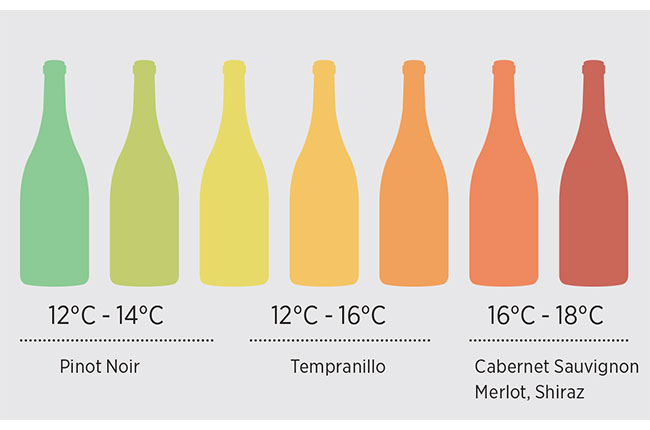Quick guide to the best red wine temperature
- Light, fruity reds: Serve these reds slightly chilled. Aim for around 12-13 degrees Celsius (54 – 56 degrees Fahrenheit), but some can go down to 10 degrees, too.
- Medium-bodied reds: Serve between 14 and 16 degrees Celsius (56 – 60 degrees Fahrenheit)
- Full-bodied reds: Serve between 16 and 18 degrees Celsius, (61 – 65 degrees Fahrenheit)
What does ‘room temperature’ mean when serving red wine?
The old adage about room temperature can be something of a red herring.
Which room are we talking about, for a start? Essentially, though, even the boldest of full-bodied red wines don’t need a serving temperature much above 18 degrees Celsius – 65 degrees Fahrenheit.
Can you serve red wine chilled?
As a general rule, lighter styles of red wine can be served at lower temperatures.
Some light-bodied red wines benefit from chilling, too.
When recommending lighter summer wines in Decanter magazine’s September 2020 issue, Peter Richards MW wrote that ‘good summer reds should be served at 10°C-16°C (50°F-60°F)’.
He added, ‘That’s significantly cooler than many a summer’s day, so don’t be afraid to pop them in the fridge for 30 minutes before serving.’
It can be hard to generalise about particular wines or grape varieties due to variations in winemaking styles.
But you’d typically find Beaujolais (Gamay) and Valpolicella Classico (Corvina) towards the lighter, chilled end of the serving temperature spectrum.
The below graphic from Decanter’s archive shows how Pinot Noir would generally range from light to medium-bodied, with some styles of Rioja (Tempranillo) in the mid-range and then the Cabernet Sauvignon-dominant and Syrah / Shiraz wines of this world in the full-bodied band.

Credit: Annabelle Sing / Decanter
Oak, ageing and structure
Certain grape varieties just have more tannin, colour and potential to create full, structured wine than others.
Yet the age of the wine and also how it has been handled in the cellar can affect things.
This Bonterra ‘young red’ 2018 from Mendocino County in California, for instance, is made from Grenache with Malbec, yet it’s produced in a style that would be ideal when served chilled, according to Decanter’s Chris Wilson.
If you’ve had a particular wine before and know the producer’s style then you’ll have some clues about what to expect in the bottle.
As a rule, a fuller, more structured red wine can handle slightly higher serving temperatures.
Chilling a red wine like this might amplify any oak or tannin present to the point where things could taste out of balance.
Is your red wine temperature too warm?
Equally, a red wine can become soupy if it’s served too warm.
Alcohol levels may then feel out-of-balance and the wine’s natural structure and freshness can be lost.
Wine is a question of personal taste, but these are generally considered undesirable qualities.
Many of us have probably experienced a soupy red wine at one time or another, whether on holiday in a warm climate or in a restaurant that hasn’t got its wine cellar under control. Don’t be afraid to ask for the ice bucket for a few minutes.
How can you get the serving temperature right?
A wine fridge with temperature control is obviously the gold standard here, but a simple wine thermometer can also help. It might also be helpful to know the temperature of the room you’re in.
Trust your gut instinct, too. ‘I can’t recall the last time I used a thermometer either at home or in a professional environment,’ master sommelier Xavier Rousset told Decanter in 2016.
Aside from obvious faults, how balanced does the wine taste?
If a red wine needs warming up slightly, then you can always cradle the glass in your hands to improve things.
Watch out for temperature changes during drinking, though.
‘The temperature of wine rises dramatically in the glass, so your classic 18ºC Bordeaux becomes (depending where you are) 22ºC or more in the glass very quickly,’ said Rousset.
‘The hardest thing by far is to maintain the correct temperature throughout the time of consumption.’





